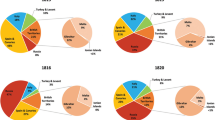Abstract
Pottery termed Colono-Ware was produced by both Indians and Black slaves in the Spanish and British North American colonies. Examples from Apalachee Province of Spanish Florida are very different from those made in the southeastern British colonies or in 16th century Hispaniola. This paper suggests that the varieties of Colono-Ware found in these different colonial contexts reflect local demographic, economic, and acculturative conditions. The European country of origin for the colony also seems to play a role in Colono-Ware design.
Similar content being viewed by others
References
Anthony, Ronald W. 1978 Descriptive Analysis and Replication of Historic Earthenware: Colono Wares from the Spiers Landing Site, Berkeley County, South Carolina. Papers of the Conference on Historic Site Archeology 13:253–68.
1986 Colono Wares. In Home Upriver: Rural Life on Daniel’s Island, Berkeley County, South Carolina by Martha A. Zierden, Lesley M. Drucker, and Jeanne Calhoun. Carolina Archaeological Services and the Charleston Museum. Submitted to South Carolina Department of Highways and Public Transportation, Federal Highway Administration Contract No. FA I–526–4(63). Columbia.
Bierce-Gedris, Katherine 1981 Apalachee Hill: The Archaeological Investigation of an Indian Site of the Spanish Mission Period in Northwest Florida, Unpublished Masters thesis, Florida State University. Tallahassee.
Boyd, Mark F., Hale G. Smith, and John W. Griffin 1951 Here They Once Stood: The Tragic End of the Apalachee Missions. University of Florida Press. Gainesville.
Ferguson, Leland 1977 Looking for the “Afro-” in Colono-Indian Pottery. The Conference on Historic Site Archeology Papers 12:68–86. Columbia.
Goggin, John M. 1968 Spanish Majolica in the New World. Yale University Publications in Anthropology No. 72. New Haven.
Noel Hume, Ivor 1962 An Indian Ware of the Colonial Period. Quarterly Bulletin of the Archaeological Society of Virginia 17(1).
Schnell, Frank T., Vernon J. Knight, and Gail S. SCHNELL 1981 Cemochechobee: Archaeology of a Mississippian Ceremonial Center on the Chattahoochee River. University Presses of Florida. Gainesville.
Shapiro, Gary 1987 Archaeology at San Luis: Broad-Scale Testing, 1984–1985. Florida Archaeology No.3. Florida Bureau of Archaeological Research, Department of State, Tallahassee.
Smith, Greg Charles 1986 Indians, Africans, and Spaniards: Locally Produced Pottery at Sixteenth Century Puerto Real, Haiti. Paper Presented at the 19th Meetings of the Society for Historical Archaeology, Sacremento.
South, Stanley 1974 Palmetto Parapets: Exploratory Archeology at Fort Moultrie, South Carolina, 38CH50. Occasional Papers of the Institute of Archeology and Anthropology, Anthropological Studies No.1. University of South Carolina, Columbia.
Tesar, Louis 1980 The Leon County Bicentennial Survey Report: An Archaeological Survey of Selected Portions of Leon County, Florida, Bureau of Historic Sites and Properties Miscellaneous Project Report Series No. 49. Florida Department of State. Tallahassee.
Author information
Authors and Affiliations
Rights and permissions
About this article
Cite this article
Vernon, R. 17th century apalachee colono-ware as a reflection of demography, economics, and acculturation. Hist Arch 22, 76–82 (1988). https://doi.org/10.1007/BF03374502
Published:
Issue Date:
DOI: https://doi.org/10.1007/BF03374502



